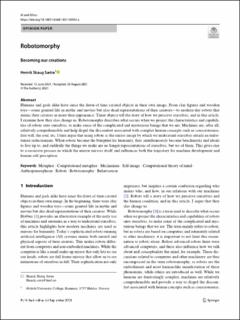| dc.contributor.author | Sætra, Henrik Skaug | |
| dc.date.accessioned | 2021-10-14T11:47:01Z | |
| dc.date.available | 2021-10-14T11:47:01Z | |
| dc.date.created | 2021-10-08T16:13:09Z | |
| dc.date.issued | 2021 | |
| dc.identifier.citation | AI and Ethics. 2021. | en_US |
| dc.identifier.issn | 2730-5953 | |
| dc.identifier.uri | https://hdl.handle.net/11250/2823021 | |
| dc.description.abstract | Humans and gods alike have since the dawn of time created objects in their own image. From clay fgures and wooden toys—some granted life in myths and movies but also dead representations of their creators—to modern-day robots that mimic their creators in more than appearance. These objects tell the story of how we perceive ourselves, and in this article, I examine how they also change us. Robotomorphy describes what occurs when we project the characteristics and capabilities of robots onto ourselves, to make sense of the complicated and mysterious beings that we are. Machines are, after all, relatively comprehensible and help dispel the discomfort associated with complex human concepts such as consciousness, free will, the soul, etc. I then argue that using robots as the mirror image by which we understand ourselves entails an unfortunate reductionism. When robots become the blueprint for humanity, they simultaneously become benchmarks and ideals to live up to, and suddenly the things we make are no longer representations of ourselves, but we of them. This gives rise to a recursive process in which the mirror mirrors itself and infuences both the trajectory for machine development and human self-perception. | en_US |
| dc.language.iso | eng | en_US |
| dc.publisher | Springer Nature | en_US |
| dc.rights | Navngivelse 4.0 Internasjonal | * |
| dc.rights.uri | http://creativecommons.org/licenses/by/4.0/deed.no | * |
| dc.subject | metaphor | en_US |
| dc.subject | computational metaphor | en_US |
| dc.subject | computational theory of mind | en_US |
| dc.subject | anthropomorphism | en_US |
| dc.subject | robots | en_US |
| dc.subject | robotomorphy | en_US |
| dc.subject | behaviorism | en_US |
| dc.subject | self-image | en_US |
| dc.subject | mechanism | en_US |
| dc.title | Robotomorphy: Becoming our creations | en_US |
| dc.type | Peer reviewed | en_US |
| dc.type | Journal article | en_US |
| dc.description.version | publishedVersion | en_US |
| dc.rights.holder | © The Author(s) 2021. | en_US |
| dc.subject.nsi | VDP::Teknologi: 500 | en_US |
| dc.subject.nsi | VDP::Humaniora: 000::Filosofiske fag: 160::Etikk: 164 | en_US |
| dc.source.journal | AI and Ethics | en_US |
| dc.identifier.doi | https://doi.org/10.1007/s43681-021-00092-x | |
| dc.identifier.cristin | 1944503 | |
| cristin.ispublished | true | |
| cristin.fulltext | original | |
| cristin.qualitycode | 1 | |

